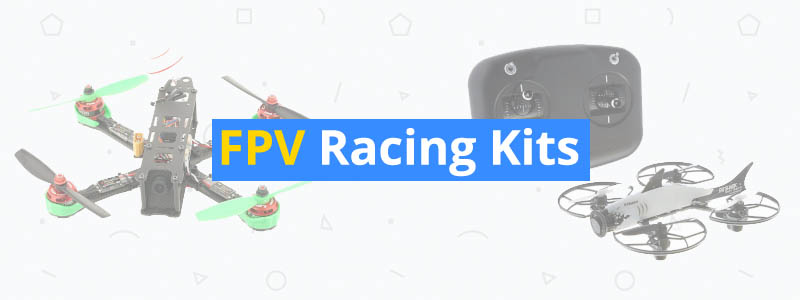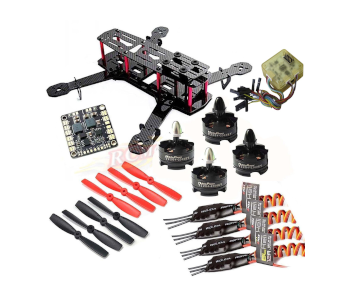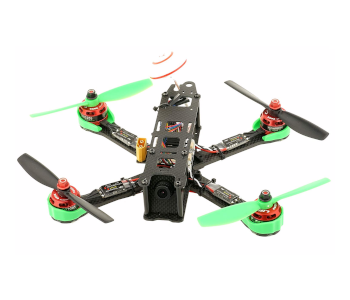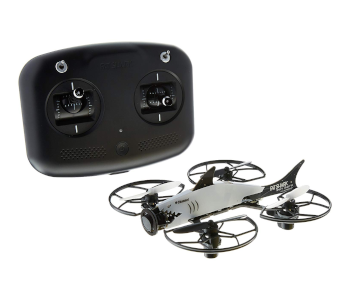6 Best FPV Racing Kits of 2019
Drone racing is a growing niche sport with more models becoming available all the time. It’s a hobby for those who love to tweak, tinker, and customize their fast flying robots. This guide looks at some incredible First Person View FPV racing kits. A kit can be any racing quad that comes with more than just the drone. Models can arrive unassembled, almost ready to fly (ARF), and ready to fly (RTF).
| Budget |
|---|
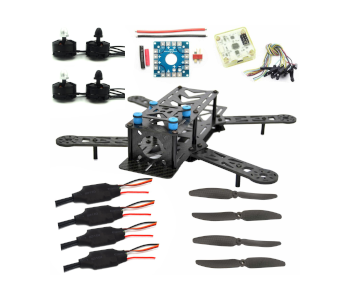 |
| LHI Pro FPV Drone Kit |
| 4.5/5.0 |
| Max Flight Time: Depends on setup |
| FPV Camera: Not included |
| Protection case for CC3D controller, programmable, portable, high-performance. |
| Check Amazon |
| Best Value |
|---|
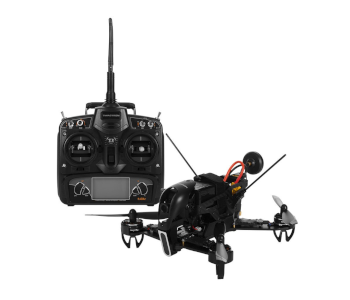 |
| SwagDrone 150-UP RTF |
| 4.6/5.0 |
| Max Flight Time: 5+ minutes |
| FPV Camera: 700 TVL |
| Beginner-friendly, carbon fiber, modular design, long range, emergency features. |
| Check Amazon |
| Top Pick |
|---|
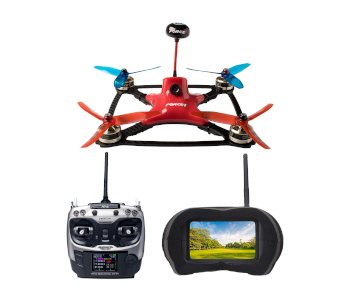 |
| Force1 XDR 220 Racing Kit |
| 4.7/5.0 |
| Max Flight Time: 5 minutes |
| FPV Camera: 5V 2.5mm CCD |
| Beginner-friendly functions, brushless motors, VR goggles, long range, spares. |
| Check Amazon |
Racing Drone Kits, RTF, ARF, BNF
Beginners should start with inexpensive ready-to-fly (RTF) quads. The natural progression is to then dabble with almost-ready-to-fly (ARF) models. Pilots often refer to these as DIY (do it yourself) kits. ARF racing drones teach you how to assemble the bird and become familiar with all its working parts. Other kits can include bind-n-fly (BNF) that may need some assembly and will need a controller or RC.
FAI Drone Racing World Cup | Biggest Event Ever
The more someone understands his or her racing quad, the better they become at piloting it. Some who get the bug go on to fly their FPV racers in local, national, and even international competitions. The biggest drone racing event in 2018 was the FAI Drone Racing World Cup. Around 670 pilots from 41 countries who took part. The title went to a French drone racer called Killian Rousseau.
All the talent at this competition started life as an amateur drone racer. It’s still a new sport, but it’s also one of the fastest growing pursuits in the world right now. There’s plenty of room for new FPV racers to shine, and life in the fast lane starts with that very first drone kit.
First Person View (FPV) Drone Racing
First Person View (FPV) is at the heart of drone racing. FPV lets you see what the drone’s camera sees in real time, from the tip of its nose. An FPV setup streams the footage to a video display or FPV goggles. The latter provides the most immersive experience, but it’s more of a challenge. Some racing kits come with goggles and or monitors, and those that don’t are still FPV-ready.
Novice FPV drone racing pilots should start slow and keep their kit simple. There’s plenty of time to progress and upgrade as skills develop. The eight considerations for FPV racing drones include:
- Lightweight, robust crash-resistant body and parts
- Top speed and acceleration speeds
- Motors: brushless is usually best—though not always—the better choice
- Maneuverability: response time, flight stability, smooth banking, lift power
- Flight time (in minutes): faster FPV racers rarely exceed single digits
- Flight controller (the drone’s nervous system)
- Reliable, intuitive remote controller RC (transmitter)
- Spare parts and accessories are easy to come by
Drone racers like to build racing quads from scratch after they develop some skills. It’s possible to buy 100% unassembled kits or even source each part separately. That’s nothing for this guide, though.
About this FPV Racing Kit Guide
There are far fewer FPV racing kits available than consumer ready-to-fly (RTF) camera quads. More kits are becoming available now due to the growing popularity of the sport. It’s still important to choose a quad racing set with care despite the limited choice. The products on this page are the result of meticulous research, personal thoughts, user reviews, and the opinions of experts.
The table below shows the racing kits as they appear on the page. The top three are Best Budget, Best, Value, and the Editor’s Top Pick.
FPV Racing Kits Comparison Table
| Make and Model | Max Flight Time | FPV Camera | Price |
|---|---|---|---|
| LHI Pro Pure Carbon Fiber FPV Drone Kit | Depends on setup | Not included | Check Price |
| SwagDrone 150-UP Ready to Fly Racing Kit | 5+ minutes | 700 TVL | Check Price |
| Force1 XDR 220 FPV Racing Drone Kit | 5 minutes | 5V 2.5mm CCD | Check Price |
| Hobbypower DIY 250 Mini Quadcopter Kit | Depends on setup | Not included | Check Price |
| Woafly LHI 220 Full Carbon FPV Race Kit | 5+ minutes | 700 TVL | Check Price |
| Fat Shark 101 FPV Drone Racing Kit | 5+ minutes | 130° CMOS | Check Price |
1. LHI Pro Carbon Fiber ARF FPV Drone Kit | Best Budget
Editor’s Rating: 4.5/5
For Best budget is the LHI Pro 280mm Almost Ready to Fly (ARF) racing copter carbon fiber frame Kit. It’s an excellent FPV-compatible racing kit for beginners keen to get into the sport.
- Best feature 1: Lightweight pure carbon fiber frame
- Best feature 2: First Person View (FPV) compatible
- Plus points: Protection case for CC3D controller, programmable, portable, high-performance
- Minus points: Some holes may need re-drilling, brittle props, no instructions
This is the kit to consider for anyone who’s keen to learn as they go. It’s an almost ready to fly (ARF) racing copter. That means you need a few items to complete the setup (see below). The CC3D Flight Controller is a stabilization hardware setup that runs OpenPilot firmware. This little quad is a high-performance bird that’s programmable, portable, and great fun to race.
What You Get/Need with an LHI Pro FPV Racing Kit
The LHI Pro FPV-compatible drone racing beginner’s kit includes:
- 250mm pure carbon fiber frame
- CC3D flight controller w/ protective case
- power distribution board (PDB)
- Simonk12A electronic speed control (ESC)
- MT2204 (2CW + 2CCVV) 2300KV brushless motors (x4)
- LED light board (x4)
- 5030 2-blade (CW/CCW) propellers (x8)
Needed to Complete
You need batteries. Look for 3–4s LiPos from 1300mAh to 2200mAh. You also need to buy a receiver and transmitter if you don’t already have them. There are various choices available, but first-timers may want to go with the suggestions. They are a Flysky FS-i6 and 2A 2.4GHz 6CH Radio System Transmitter. Other extras include standoffs for the PDB and heat-shrink tubing for the wires.
New pilots may also want to invest in a First Person View (FPV) camera setup at some point.
The Not So Good
It seems that some motor screw holes are a tad small and may need re-drilling. And the stock propellers that come with the kit are notoriously brittle, so it’s a good idea to buy better ones. The final con is that there are no detailed instructions. The good news is that there are plenty of helpful user videos uploaded to YouTube. Audiovisual guides tend to be better than written ones anyway.
| Tech Specs |
|---|
| Dimensions: 10.8 x 6.5 x 1.7” |
| Product Weight: depends on final setup |
| Frame: 250mm pure carbon fiber |
| FPV Camera: None included |
| Range: Depends on final setup |
| Battery: 3–4s LiPos from 1300mAh to 2200mAh (not included) |
| Flight time: Depends on final setup and payload |
| Transmitter: 6-channels or more (not included) |
| The Pros |
|---|
| Lightweight carbon fiber frame |
| CC3D Flight Controller |
| Protection features |
| Programmable |
| Portable design |
| High-performance |
| The Cons |
|---|
| Some holes may need re-drilling |
| Brittle stock props |
| No detailed instructions |
2. SwagDrone 150-UP RTF Racing Drone Kit | Best Value
Editor’s Rating: 4.6/5
The Best Value pick goes to the SWAGTRON SwagDrone 210-UP. It’s a ready-to-fly (RTF) RC racing drone, and that means there’s no assembly or extras to buy. It even comes with an FPV camera.
- Best feature 1: Ready-to-Fly (RTF) FPV Racing Kit
- Best feature 2: HD Night Vision Camera
- Plus points: Beginner-friendly, carbon fiber, modular design, long range, emergency features
- Minus points: Vague instructions
The SwagDrone 150-UP Highlights
The FPV camera is a 700TVL with a wide 120° Field of View (FOV). It’s also a night-vision camera. That means no break in flying fun just because the sun goes down or light levels fall. The SwagDrone 150-UP is an excellent choice for the advanced beginner, but not the raw novice. It’s just too feisty for first-time drone pilots. The stock setup has a lightweight carbon fiber frame and modular design.
The modular design means the quad consists of smaller parts, or modules. That’s especially useful for a racing drone as it makes repairs quick and easy. The SwagDrone has a 5.8 GHz mushroom antenna and an impressive 800m transmission range. The safety features include a locator alarm, out-of-range protection, and an invaluable kill switch.
There are also three flying modes to ease you in, i.e., Primary, Mid-Level, and High-Level.
What You Get/Need with a SwagDrone 150-UP Racer
The SwagDrone 150-UP RTF Racing Drone Kit includes:
- SWAGTRON SwagDrone 210-UP RC racing quadcopter w/ carbon fiber body
- HD night vision camera
- 5.8Ghz transmitter
- 2S flight battery
- Battery charger
- Instruction booklet
There are other variations of this kit including SWAGTRON SwagDrone 210-UP w/ FPV Goggles.
Needed to Complete
The only items needed to complete this kit are batteries for the transmitter. Everything else is in the box and ready to go. It’s possible to modify the quad with upgraded parts later if you wish.
The Not So Good
The only shared complaint with this quadcopter racing kit is its quick guide. It’s far too vague, especially for novice pilots. Poor instructions are typical for these models. Don’t worry, YouTube has some helpful tutorials to make up for the lack of paper directions.
| Tech Specs |
|---|
| Dimensions: 7.2 x 7.2 x 4” |
| Product Weight: 13.1 oz. (371g) |
| Frame: Carbon fiber |
| FPV Camera: 700 TVL w/ 120° angle |
| Range: 2,625 ft. (800m) |
| Battery: 14.8V 1300mAh 40C 4S LiPo |
| Flight time: 5+ minutes |
| Transmitter: 2.4Ghz controller |
| The Pros |
|---|
| Ready-to-Fly (RTF) FPV Racing Kit |
| HD Night Vision Camera |
| Advanced Beginner-friendly kit |
| Lightweight carbon fiber frame |
| Modular design |
| Long range |
| Safety/emergency features |
| The Cons |
|---|
| Vague quick start guide, no comprehensive manual |
3. Force1 XDR220 RTF Racing Drone FPV Kit |Top Pick
Editor’s Rating: 4.7/5
The Top Pick goes to the capable Force1 racing drone. It’s a full, ready-to-fly (RTF) kit. It comes with a First Person View (FPV) camera, VR Goggles, an SP F3 Flight Controller, and more.
- Best feature 1: HD CCD camera w/ sensor
- Best feature 2: SP F3 Flight Controller
- Plus points: Beginner-friendly functions, brushless motors, VR goggles, long range, spares
- Minus points: Short flight time, no batteries included
Force1’s XDR 220 racing drone is an excellent choice for eager beginners despite its power and sophistication. It has some user-friendly flight features usually found on regular camera quadcopters. There’s 1-Key takeoff/landing, Altitude Hold, and even a Headless Mode. The powerful brushless motors and propulsion system make it equally attractive to skilled racers.
A Truly Immersive Experience
Drone racing is all about control via First Person View (FPV). Racing pilots achieve the ultimate immersive FPV experience by wearing goggles. The alternative is to view via a monitor. The XDR220 racing drone kit includes a set of high-quality Eachine 007 FPV goggles. They have a large clear screen with full peripheral view to provide the best FPV experience.
This drone kit has everything you need to start racing. It’s super-fast, agile (360° flips), and has a 3000 feet (900m) control range. It’s too far—say some—considering the short flight time (see below).
What You Get/Need with an XDR 220 Racing Drone Kit
The Force1 XDR 220 RTF Racing Drone FPV Kit includes:
- FPV 220 racing quad
- FPV goggles
- AT9 transmitter
- Spare set of propellers
- Mushroom antenna
- Balance charger for flight battery
- Carbon fiber cover for the battery
- Drone carrying case reinforced with carbon fiber
- Screwdriver & wrench
- Spare screws (x4)
- M5 nuts (x6)
- Spare Velcro
- User Manual
Needed to Complete
This kit comes with a battery charger but no flight battery. That’s unusual for a ready-to-fly (RTF) model. Force1 probably did that to keep the retail cost below a certain number. Anyway, the suggested battery is an 11.1V 1300mAh 45C 3S1P and costs about $24 at the time of writing. The RadioLink AT9 controller also needs eight AAs though most kits don’t include batteries for the RC.
The Not So Good
Racing quads use a lot of power and that has a negative impact on flight time (battery life). You can expect 5-minutes on a single charge with flat-out racing. It’s terrible but typical, so be sure to buy some spares. The second negative is that there’s no flight battery included. You want extras anyway, so factor the cost of spares into the total price of the kit.
| Tech Specs |
|---|
| Dimensions: 15.1 x 9.6 x 8.9” |
| Product Weight: 10.88 oz. (308g) |
| Frame: Solid carbon fiber |
| FPV Camera: 5V 2.5mm CCD |
| FPV Goggles: Eachine 007 |
| Range: 3000 ft. (900m) |
| Battery: 11.1V 1300mAh 45C 3S1P (not included) |
| Flight time: 5 minutes |
| Transmitter: 5.8G 40 channel 25mW/200mW |
| The Pros |
|---|
| HD CCD camera w/ sensor |
| Quality SP F3 Flight Controller |
| Beginner-friendly flight functions |
| Powerful SE2205-2300K brushless motors |
| VR goggles included |
| Long flight control range |
| Spare parts included |
| The Cons |
|---|
| Short flight time |
| No batteries included (flight or controller) |
4. Hobbypower DIY QAV250 Quadcopter Frame Kit
Editor’s Rating: 4.2/5
This is Hobbypower’s affordable DIY, mini quadcopter frame kit. It’s a good-looking drone with a durable rack and stable structure for smooth flights.
- Best feature 1: Easy to build from advanced-beginner level
- Best feature 2: Stable structure
- Plus points: Affordable, carbon fiber frame, FPV compatible, spare parts pack included
- Minus points: Holes may need re-drilling, vague instructions
This lightweight racing quad uses a typical carbon fiber frame with 3mm arms. It’s an advanced-beginners kit and there’s much to do as you assemble the bird. There’s also some soldering involved. You may want to practice flying the quad before racing it or adding First Person View (FPV) gear.
What You Get/Need with a DIY QAV250 Frame Kit
The DIY QAV250 quadcopter racing frame kit includes:
- QAV250 Full carbon frame kit
- HP T2204 CW/CCW 2300KV brushless motors (x4)
- Emax BLHeli 12A speed controllers (x4)
- 5045 CW/CCW red & black propellers (x4, two pairs)
- CC3D flight controller w/ protective case
- Matek power hub
- Spare parts pack
Needed to Complete
This is a DIY kit and needs a transmitter, receiver, and a battery to complete. Choose a radio system with 6-channels (CH) or more. Consider the Flysky FS-i6 6CH 2.4G AFHDS 2A LCD Transmitter iA6 Receiver Radio System or similar. Battery suggestions are 3S 1000mah to 1800mah LiPo.
The Not So Good
Some users complain that the holes for the motors are not big enough. This is quite typical with budget-end FPV racing frame kits. New kit owners should expect to do a little re-drilling. The instructions are scant and more of a parts list than an actual guide. That’s one reason this kit is best suited to advanced-beginners rather than first-timers. YouTube should help if you get stuck.
| Tech Specs |
|---|
| Dimensions: Not specified |
| Product Weight: Depends on final setup |
| Frame: Full carbon fiber |
| FPV Camera: Compatible but no FPV setup included |
| Range: Depends on final setup |
| Battery: 3S 1000mah to 1800mah LiPo (not included) |
| Flight time: Depends on final setup |
| Transmitter: Flysky FS-i6 6CH 2.4G AFHDS 2A LCD (not included) |
| The Pros |
|---|
| Easy to build at the advanced beginner level |
| Stable structure |
| Affordable kit for trainee racers |
| Robust carbon fiber frame |
| FPV compatible |
| Spare parts pack included |
| The Cons |
|---|
| Holes may need re-drilling |
| Scant (next to useless) guide |
5. Woafly Full Carbon Frame FPV Quad ARF Race Kit
Editor’s Rating: 4.3/5
This is the Woafly LHI 220 racing quadcopter Kit and an upgraded version of the QAV250. It’s another interesting DIY model for racing enthusiasts to assemble from the ground up.
- Best feature 1: Pure carbon fiber box style frame w/ 4mm arms
- Best feature 2: 700TVL FPV camera
- Plus points: Assembly videos, motor guard/pads, extra blades, all nuts & standoffs included
- Minus points: No manual, limited camera angle, camera needs better screws
First Person View (FPV) Ready Racing Quad
This kit comes with a stock 700TVL FPV camera and mounting plates to attach it to the frame. The camera gives an excellent introduction to First Person View (FPV), but it’s old tech. Most racing enthusiasts are sure to upgrade to a camera that has a better lens with a wider-angle.
The pure carbon fiber frame is the popular racing box style with 4mm arms. The arms are a bit heavier than 3mm, but what they add to the weight they make up for in strength. The LHI 220 is an excellent beginner-friendly kit. The two video assembly tutorials are a great help for those who need guidance. This race kit includes optional motor guards and pads, extra props, and has all the standoffs and nuts.
What You Get/Need with an LHI 220 Racing Quad Kit
The Woafly LHI 220 Racing Quadcopter Kit includes:
- LHI 220 racing quadcopter pure carbon fiber frame
- F3 flight controller board Cleaflight 6DOF standard
- 700TVL FPV camera
- FPV 5.8Ghz antenna
- PDB-XT60
- TS5828 5.8G FPV 32CH 600mW TX transmitter
- DX2205 CW/CCW 2300KV brushless motors (x4)
- Motor guard protector caps
- Littlebee 20A Mini ESC
- LED (x4)
- 5045 propellers (x4)
Needed to Complete
The Woafly LHI 220 is a DIY kit, so it needs extras to complete it. These include a radio transmitter, a receiver, and LiPo flight battery. The suggested receiver for this model is T6/I6. There are also suggestions for LiPo batteries. Any of the following should be fine: 11.1V 3S 1300mah, 11.1V 3S 1500mah, 14.8V 4S 1300mah, and 14.8V 4S 1500mah. You may also want to consider FPV goggles.
Below are a few essential tools and disposables needed to build the quad:
- 2mm & 2.5mm Allen wrench
- Flush cutters
- A Phillips screwdriver
- Soldering iron
- Solder
- Heat shrink (assorted)
- Loctite
- Electrical tape
That should cover everything, but add anything else to the list that may be of use to you.
The Not So Good
There’s no assembly manual though there are video assembly tutorials available. Some people prefer paper guides, but there’s nothing for this kit (at the time of writing). Another setback is the restricted camera angle. FPV racing—at least at a competitive level—needs a wider field of view (FOV). The final con is the plastic pegs used to keep the camera in place. Stronger screws would fare much better here.
| Tech Specs |
|---|
| Dimensions: 10 x 5.1 x 3” |
| Product Shipping Weight: 1.3 lbs. |
| Frame: Pure carbon fiber |
| FPV Camera: 700TVL FPV |
| Range: Depends on setup |
| Battery: 3SD, 4S LiPo (see review) |
| Flight time: 5+ minutes |
| Transmitter: Required (not included) |
| The Pros |
|---|
| Pure carbon fiber box style frame w/ 4mm arms |
| 700TVL FPV camera |
| Helpful assembly videos |
| Motor guard/pads Extra blades included |
| All nuts & standoffs included |
| The Cons |
|---|
| No manual available |
| Limited camera angle |
| Camera needs better screws to secure it to the frame |
6. Fat Shark 101 FPV Quadcopter Racing Kit
Editor’s Rating: 4.3/5
Last on the list is the Fat Shark FPV Drone Racing Kit. It’s an unusual looking quad but don’t let that put you off. They call it the ‘FAT SHARK 101 DRONE TRAINING SYSTEM.’
- Best feature 1: Sleek micro-quad design
- Best feature 2: High-quality Recon goggles with wide field-of-view (FOV)
- Plus points: Affordable, advance beginner-friendly, upgradable, durable build, training vids
- Minus points: Short flight time, takes practice to fly well
Fat Shark’s 101 is the perfect starter kit that’s ready to fly right out of its box. It comes with the racing quad and a simple radio controller. The package also includes Fat Shark Recon First Person View (FPV) goggles and a takeoff/landing pad. The goggles provide the most immersive FPV experience—the heart of all quad racing. The kit is upgradable and can work with high-end FPV goggles and radio systems.
The drone is easy to fly and control for anyone with a little experience. That puts it at the advanced beginner level and above. The quad is also reasonably crash resistant thanks to its sturdy build.
What You Get/Need with a Fat Shark 101 FPV Training Kit
The basic Fat Shark 101 FPV racing drone starter kit includes:
- The Fat Shark racing drone
- The Fat Shark radio controller
- The Fat Shark Recon goggles
New owners of the Fat Shark 101 should register their drone with the company. Registration provides free insurance and includes an entire series of excellent training videos.
Needed to Complete
Nothing. Everything you need to start racing is right there in the box.
The Not So Good
The flight time is a familiar—yet disappointing—5 minutes. Extra LiPo battery kits typically come with a couple of batteries and a USB charger. The prices start at around $15+ dollars. The only other negative is flying the quad. Experienced drone pilots shouldn’t have any problems, but it’s a tricky bird to master at the entry-level. Expect a few crashes as you learn to handle the Fat Shark 101.
| Tech Specs |
|---|
| Dimensions: 12.6 x 9 x 5” |
| Aircraft only Weight: 1.76 oz. (50g) |
| Frame: Durable plastic |
| FPV Camera: 130° CMOS |
| Range: 100 feet (30 meters) |
| Battery: 2s 260mAh in plastic case |
| Flight time: 5+-minutes |
| Transmitter: Dedicated Fat Shark Radio Controller (RC) |
| The Pros |
|---|
| Affordable RTF FPV racing quad |
| Sleek micro-quad design |
| High-quality Recon goggles with wide field-of-view (FOV) |
| Advance-beginner friendly |
| Upgradable |
| Durable build |
| Series of training vids |
| Free insurance |
| The Cons |
|---|
| Short flight time |
| Takes practice to fly well |
Contents
- Racing Drone Kits, RTF, ARF, BNF
- FAI Drone Racing World Cup | Biggest Event Ever
- First Person View (FPV) Drone Racing
- About this FPV Racing Kit Guide
- FPV Racing Kits Comparison Table
- 1. LHI Pro Carbon Fiber ARF FPV Drone Kit | Best Budget
- What You Get/Need with an LHI Pro FPV Racing Kit
- Needed to Complete
- The Not So Good
- 2. SwagDrone 150-UP RTF Racing Drone Kit | Best Value
- The SwagDrone 150-UP Highlights
- What You Get/Need with a SwagDrone 150-UP Racer
- Needed to Complete
- The Not So Good
- 3. Force1 XDR220 RTF Racing Drone FPV Kit |Top Pick
- A Truly Immersive Experience
- What You Get/Need with an XDR 220 Racing Drone Kit
- Needed to Complete
- The Not So Good
- 4. Hobbypower DIY QAV250 Quadcopter Frame Kit
- What You Get/Need with a DIY QAV250 Frame Kit
- Needed to Complete
- The Not So Good
- 5. Woafly Full Carbon Frame FPV Quad ARF Race Kit
- First Person View (FPV) Ready Racing Quad
- What You Get/Need with an LHI 220 Racing Quad Kit
- Needed to Complete
- The Not So Good
- 6. Fat Shark 101 FPV Quadcopter Racing Kit
- What You Get/Need with a Fat Shark 101 FPV Training Kit
- Needed to Complete
- The Not So Good

